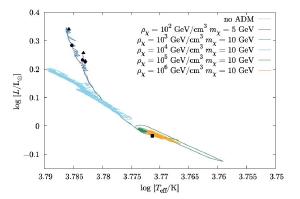Blog
Dark Star
15 April 2014
Although still mysterious, dark matter is five times more plentiful than regular matter in the universe. It affects the formation and clustering of galaxies, as well as the motion of stars through their galaxy. So it is tempting to wonder what effect dark matter might have on the formation and evolution of stars themselves. The problem is we can’t be sure without an understanding of type of dark matter which exists. That hasn’t stopped some astronomers from speculating, however.
 Iocco, et al
Iocco, et alOne idea is that dark matter could accumulate in the core of stars.1 Given the current estimated density of dark matter around stars like the Sun, this wouldn’t have a significant effect, but if the density were about 200 times more dense, and if dark matter is a type known as asymmetric dark matter (ADM) then it could affect the brightness of stars, particularly those sun-sized or smaller.
One of the ideas about dark matter is that it is likely made up of some yet-unknown type of particles (WIMPs). Just as regular matter particles have corresponding anti-matter particles, dark matter particles could also have anti-matter siblings. Asymmetric dark matter is a hypothetical type of dark matter where there is an asymmetry between regular dark matter and anti-dark matter. This would mean that the two types wouldn’t annihilate each other very effectively, so the type of gamma ray signal some astronomers have looked for (and might have found) wouldn’t be very strong.
But such ADM would interact with the nuclear reactions inside the core of a star. As a result of these interactions, fusion would occur more efficiently, and therefore the star would produce more light and heat than expected. For large stars, this extra boost would be small compared to the pure matter rate, but for smaller stars (particularly red dwarf stars) this extra boost could be significant. As a result, small stars could be brighter and hotter than expected.2
We think dark matter would have a higher density around the core of a galaxy. So the density of dark matter in that region might be high enough to have a measurable impact on stellar fusion. If that’s the case, then we should be able to observe red dwarf stars near galactic center that are hotter and brighter than their mass predicts. Observing such red dwarf stars in our own galactic core would be difficult because of all the gas and dust in that region, but perhaps such an effect could be observed in other galaxies.
Just to be clear, this is still pretty speculative. Dark matter remains a big mystery, and it might not be ADM. But it is good to develop these types of models to determine what effects there might be. That way if we start seeing these effects they can lead us to the correct model.